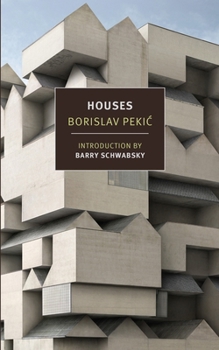Houses
Select Format
Select Condition 
Book Overview
Building can be seen as a master metaphor for modernity, which some great irresistible force, be it fascism or communism or capitalism, is always busy building anew, and Houses is a book about a man,... This description may be from another edition of this product.
Format:Paperback
Language:English
ISBN:1590179471
ISBN13:9781590179475
Release Date:April 2016
Publisher:New York Review of Books
Length:240 Pages
Weight:0.58 lbs.
Dimensions:0.5" x 5.0" x 8.0"
Related Subjects
Contemporary Fiction Genre Fiction Historical Literary Literature & Fiction World LiteratureCustomer Reviews
2 ratings
A neccessary piece of literature
Published by Thriftbooks.com User , 23 years ago
In his book "Houses of Belgrade (the original serbian title "A Pilgrim of Arsenije Njegovan"), continues his masteful work on the history of family Njegovan. Through the history of one typical serbian family Pekic depicts the last two centuries of Serbian (+ Balkan + East Europian) history. His previous 7-volume work "Golden Fleece" (Zlatno Runo) illustrates the historical events in that part of the world from 1848 through 1941. This book presents a logical continuation of events from 1945 through 1968. Through the story about Arsenije Njegovan, one of the last descendant of one-time rich and powerful family Njegovan, Pekic depict historical events that took place after the arrival of communism in Serbia.Borislav Pekic, one of the most prolific serbian authors after the World War II, and more importantly, the greatest serbian intellectual in that period, uses his unsurpassed observation skills, sharp cinicism and self sarcasm to both critice and explain the unfortunate turn of events that placed Serbia in the jaws of communism. This book as well as the whole Pekic's opus had an decisive impact on the generations of Serbs. Furthermore, his opus is a must for all people interested in the history and national mentality of Serbs.
convinced to explore the "unbound" series
Published by Thriftbooks.com User , 24 years ago
I picked "Houses" up on a remainder shelf in a bricks-and-mortar bookstore. The story is set around certain historical events in Belgrade: student riots in 1968; Germany's attack in 1941; and Serbia's entry into World War One. Horrible to admit in a review, I am sure, but I did not fully understand the references in the book.Pekic tells the story in the first-person; the character is a landlord of several houses in the city. Arsenie Negovan is losing his sanity. What better character to relate the tale of a city half-heartedly embracing communism: a landlord, losing his mind, recalling his houses when they were young, lamenting their loss. Here is a sample: "For just as people who have done nothing at all wrong are got rid of simply because they stand in the way of something, so houses too are destroyed because they impede somebody's view, stand in the way of some future square, hamper the development of a street, or traffic, or of some new building." Again, on being a landlord and a man of commerce, "...the very act of possession would be so completely reciprocal that sometime, perhaps in some perfect world, it would become one with the act of self-perception."With this ironic tone, the deranged voice of a once decent man of property, the history of human struggle in the city unfolds. Buildings are talked about as beings. People are inanimate. Yet human action transforms the place. The loss of the old city is tragic. The grand old houses decay. Present buildings are inferior to their predecessors-- a succinct way to measure the progress of a society. Within this narrative about property and architecture, Arsenie explains his motives, wonders about his soul, and spouts what he has learned during a lifetime of accumulation.The book was exactly what I was looking for when I plucked it off the remainder shelf: a new direction in my reading. I will look for others in the series, and I recommend "Houses" to readers looking for something different. (My apologies to more knowledgable readers of Pekic.) I will be reading other titles in the "Writings from an Unbound Europe" series.






